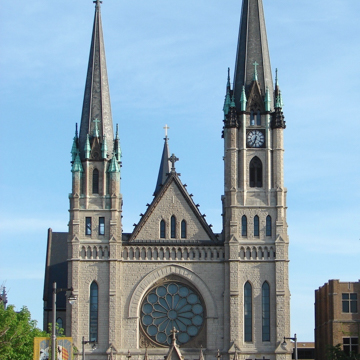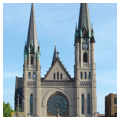This is perhaps the city’s most imposing Gothic Revival ecclesiastical building. The exterior, with its large rose window, complementary but not symmetrical towers, and details, draws inspiration from French medieval churches. Gesu’s walls are clad in huge, rock-faced limestone blocks. The stone entrance vestibule, richly adorned with some of the finest Gothic-style stone carving in the Midwest, was designed by Milwaukee architect Esser.
The cavernous interior of Gesu church features a colonnade of massive polished-granite piers supporting a four-part vaulted plaster ceiling. The magnificent stained glass windows, dominated by rich hues of red and blue, depicting various saints and the life of Christ, were designed and made in Munich, Germany, at the Royal Bavarian Art Institute under the supervision of F. X. Zettler. The stone-framed Gothic altars were built in 1927. The interior acoustics enhance Gesu’s impressive Kilgen pipe organ, which was moved here from Chicago’s Studebaker Theatre and boasts a compelling timbre.


















